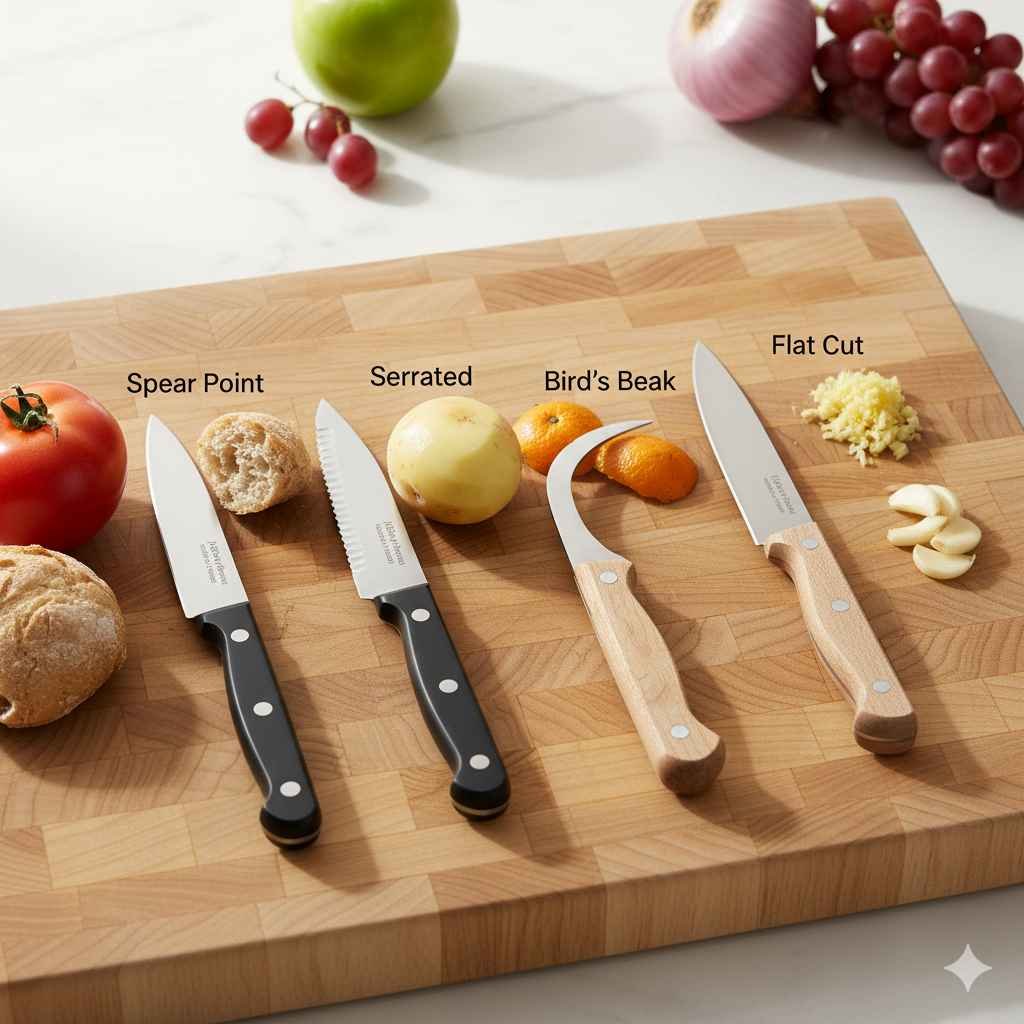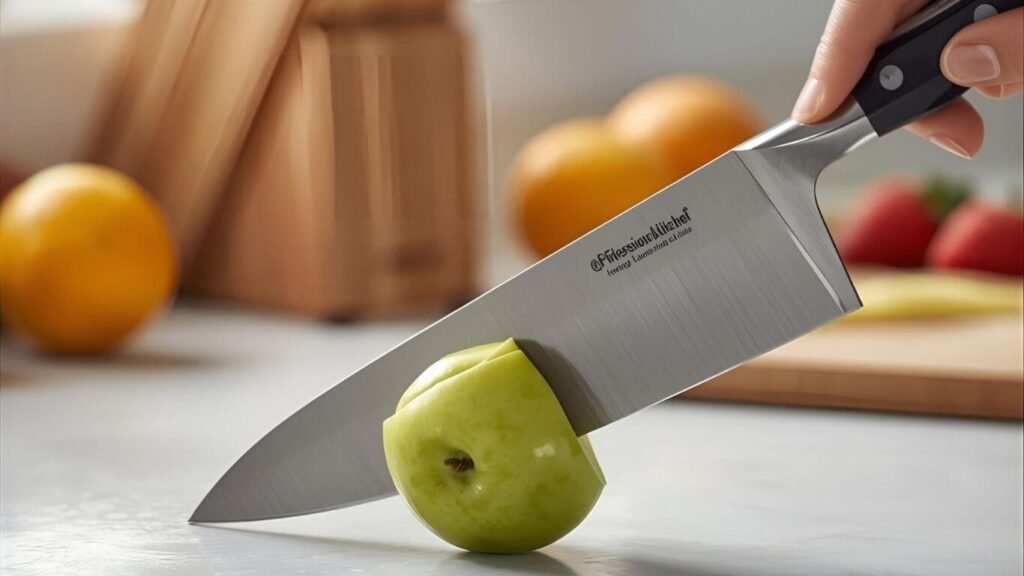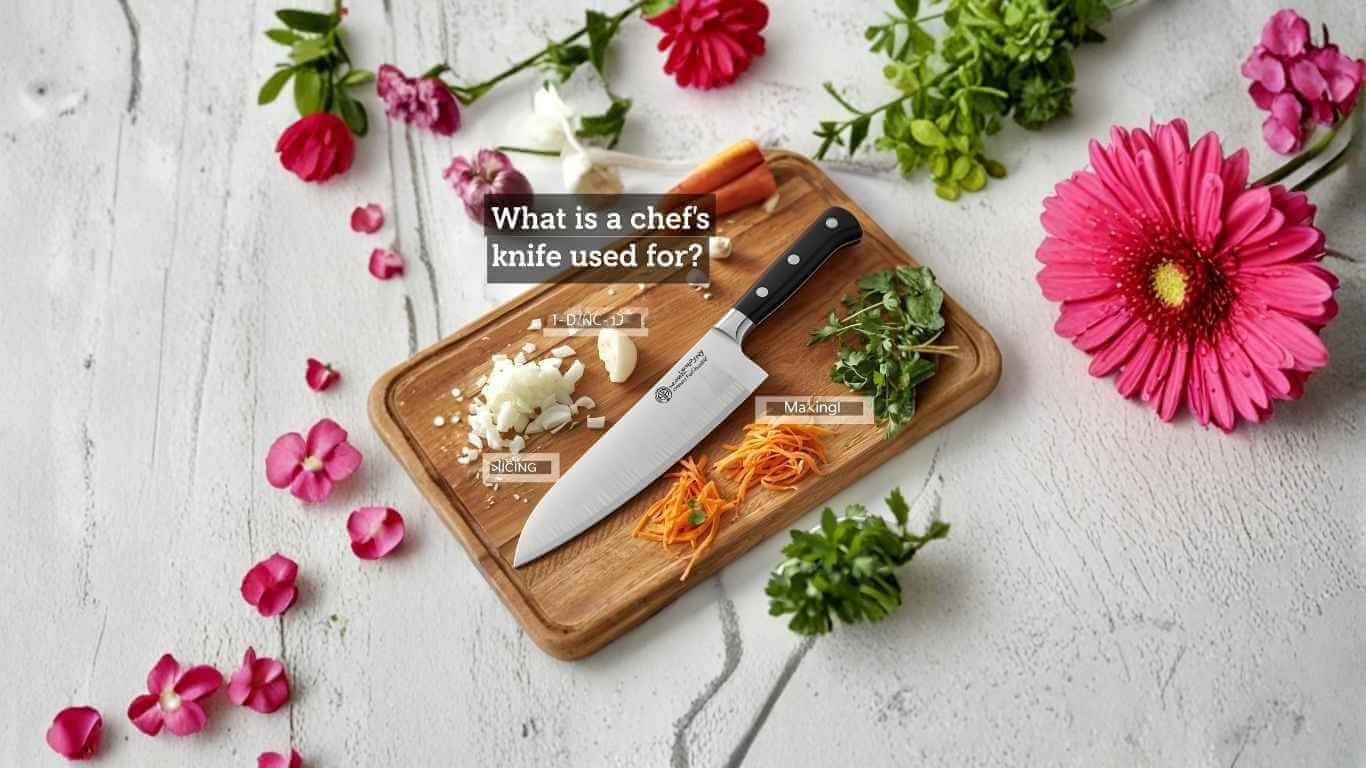If you open any professional chef’s knife roll, you will undoubtedly find a massive 8-inch chef’s knife. But right next to it, tucked securely in its slot, will be a small, unassuming blade that sees just as much action: the paring knife.
So, what is a paring knife used for? In short, a paring knife is used for precise, detailed kitchen tasks where a larger blade would be clumsy or dangerous, such as peeling fruits, hulling strawberries, deveining shrimp, and creating intricate garnishes.
While the chef knife or santoku knives are your workhorses for heavy chopping, the paring knife is your scalpel. It offers a level of control that larger knives simply cannot match. Whether you are a home cook looking to refine your skills or simply wondering which knife to grab for a basket of citrus fruits, understanding the versatility of this tool is the first step toward kitchen mastery.
What Is a Paring Knife?
Before diving into techniques, it helps to understand the anatomy of the tool. A paring knife is a small kitchen knife with a short blade, typically measuring between 2.5 and 4 inches long. It is designed to be lightweight and agile, fitting comfortably in your hand for “off-the-board” work (cutting while holding the ingredient in the air).
Design and Materials: Western vs. Japanese
A quality paring knife mimics the construction of high-end cutlery, just on a smaller scale.
- Western knives: Typically feature heavier handles and softer stainless steel that is durable and easy to maintain. They often have a curved belly to allow for rocking cuts.
- Japanese knives: Often made from harder steel with thinner blades for extreme sharpness.
When choosing materials, you often have to decide between stainless steel and carbon steel. While stainless steel is rust-resistant, a carbon steel blade can get significantly sharper and hold its edge longer, though it requires more care to prevent patina and rust.
Usage Comparison
Think of the difference between a sledgehammer and a chisel. If you try to use a large blade to remove the seeds from a jalapeño or peel a ginger root, you risk cutting yourself. The paring knife fills the gap left by larger tools, such as bread knives or heavy choppers, offering precision where power isn’t required.
Different Types of Paring Knives
Not all paring knives are created equal. While they all serve the general purpose of detailed cutting, variations in blade shape change their specific utility.
- Spear Point Paring Knife: The classic “all-rounder.” The edge is slightly curved, allowing you to rock the blade gently on a cutting board, while the sharp point is excellent for piercing.
- Serrated Paring Knife: This is a game-changer for foods with tough skins and soft interiors. It acts like a miniature tomato knife or bread knife, sawing through waxy tomato skins or crusty rolls without squashing the soft inside.
- Bird’s Beak Paring Knife (Peeling Knife): This blade curves inward, resembling a sickle. It is a specialized tool used primarily for peeling round fruits or creating the classic French “tourné” cut.
- Flat Cut Paring Knife (Sheep’s Foot): Also known as a sheep’s foot blade, this style has a completely straight cutting edge with a rounded spine. It offers fantastic contact with the cutting board, making it ideal for straight chopping or julienning ginger.

What Are Paring Knives Used For?
The paring knife is arguably the most versatile tool in your kit for prep work. Below are the primary techniques where this small blade outshines the rest.
Peeling Fruits and Vegetables
While a standard vegetable peeler excels at peeling long carrots, a paring knife offers superior control for delicate or irregular items. When asking “what are paring knives used for,” peeling is the most classic answer. Use it to remove the thin skin from apples, kiwis, or peaches. A flat cut paring knife is particularly good here, as the straight edge helps control the thickness of the peel.
Coring and Hulling
Have you ever tried to remove the stem from a strawberry with a large knife? It usually results in slicing off the entire top of the berry. A paring knife’s sharp tip allows you to cut a small cone shape around the stem (hulling) to remove the green top while keeping the fruit intact.
Mincing and Dicing Small Ingredients
For small, pungent ingredients like shallots, garlic cloves, or chili peppers, a large chef’s knife can seem excessive. A paring knife allows for tight, controlled dicing. Because the blade is short, you can make vertical and horizontal cuts into a garlic clove with extreme precision before mincing it finely.
Deveining Shrimp and Trimming Meat
When prepping proteins, you often need to perform surgical tasks. While professional butchers use boning knives for breaking down whole chickens, a paring knife is the standard tool for home cooks to devein shrimp or trim silver skin off tenderloins. It offers enough agility to remove excess fat without butchering the meat.
Scoring and Decorating
Presentation matters. Bakers use paring knives to score dough, cutting slashes into the top of bread loaves to control expansion. In savory cooking, you might use it to create decorative vegetable garnishes.
Segmenting Citrus Fruits (Supreming)
If you want to elevate a salad, you “supreme” your citrus. This involves cutting the skin and white pith off an orange, grapefruit, or lime. While a serrated paring knife can help get through the initial thick skin, a smooth blade is best for sliding cleanly between the membranes to release the juicy segments.
Everyday Kitchen Uses
Beyond professional techniques, this knife is a daily problem solver. It serves as a stand-in for cheese knives when cutting hard blocks of Parmesan or cheddar for a snack. It opens stubborn plastic food packages and handles quick jobs where you don’t want to dirty a large blade.

How to Hold and Use a Paring Knife Safely
Because paring knives are often used in the air (holding the food item in your hand rather than on a board), grip is crucial for safety.
- The Lofting Grip (Peeling Grip): Hold the handle with your bottom three fingers. Place your thumb on the food item (like an apple). As you cut, you gently pull the blade toward your thumb. Note: The thumb acts as a guide, but you must control the pressure to stop the blade before it comes into contact with your skin.
- The Pinch Grip: When using the knife on a cutting board (similar to how you hold Santoku knives), pinch the base of the blade between your thumb and index finger. This gives you maximum control over the tip.
Features That Define a Quality Paring Knife
If you are looking to upgrade your kitchen tools, keep these features in mind:
- Blade Material: Carbon steel gets incredibly sharp but requires maintenance. High-carbon stainless steel is the standard for most Western knives, offering a balance of sharpness and rust resistance.
- Handle Comfort: Since you manipulate this knife with your fingers, the handle should feel secure and comfortable.
- Edge Retention: A good paring knife should be razor-sharp out of the box.
- Maintenance: Store it in a knife block to protect the edge. Avoid throwing it loose in a drawer where it can bang against boning knives or spatulas.
Paring Knife vs. The Rest of the Block
A common question is whether a paring knife is necessary if you already have a full set. Here is how it compares:
| Knife Type | Vs. Paring Knife |
| Chef Knife | The chef knife is for power and volume (chopping onions); the paring knife is for precision and air-work. |
| Vegetable Peeler | A peeler is faster for long strokes, but a peeling knife (paring) is better for round or bumpy items like ginger. |
| Tomato Knife | A serrated paring knife can often double as a tomato knife for small produce, gripping the skin easily. |
| Cheese Knives | While specialized cheese knives have holes in the blade to prevent sticking, a stiff paring knife works perfectly for cutting hard cheeses. |
Paring Knife vs. Chef’s Knife (and When to Use Each)
A common question for beginners is whether they really need both. The answer is yes.
| Feature | Chef’s Knife | Paring Knife |
| Blade Length | 8 to 10 inches | 2.5 to 4 inches |
| Primary Use | Chopping, slicing, heavy prep | Peeling, coring, detail work |
| Cutting Surface | Always a cutting board | Board or in-hand (air) |
| Best For | Watermelons, onions, meat | Strawberries, garlic, citrus |
Frequently Asked Questions
What is the best way to sharpen a paring knife?
Because the blade is small, a whetstone works well. However, knowing how to sharpen kitchen knives correctly is essential to prevent damaging the tip.
Can a paring knife cut meat?
Yes, but it is best for trimming fat rather than slicing steaks. For slicing cooked meat, use a carving knife; for raw butchery, boning knives are preferred.
What is a flat cut paring knife used for?
Also known as a sheep’s foot, the flat cut paring knife is designed for chopping on a cutting board. The straight edge ensures the entire blade makes contact with the cutting board at once, unlike a curved spear point.
Is a paring knife necessary if I have a chef’s knife?
Absolutely. Attempting delicate “in-hand” work, such as hulling strawberries with a massive chef’s knife, is a major safety hazard.
Final Thoughts
So, what are paring knives used for? Everything that requires a gentle touch and a sharp eye. From the morning ritual of slicing strawberries to the evening prep of mincing garlic, the paring knife is an indispensable ally.
It may be the smallest knife in the block, but its impact on your cooking is massive. Whether you prefer the robust feel of Western knives or the razor edge of Japanese knives, investing in a quality model is one of the smartest upgrades you can make.
Ready to improve your knife skills? Add a quality paring knife to your collection today and master everyday prep with confidence.



